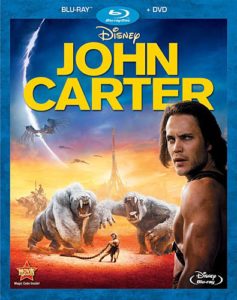 This morning, we were delighted to be invited to be a part of a virtual roundtable to celebrate the DVD and Blu-ray release of Disney’s John Carter. President of Edgar Rice Burroughs Inc, James J. Sullos Jr. and archivist Cathy Wilbanks were on hand to answer questions about their involvement in the film, the maintenance of the archives, their role in the 100 Years in the Making piece for the DVD/Blu-ray, the future of the properties and the legacy of Edgar Rice Burroughs.
This morning, we were delighted to be invited to be a part of a virtual roundtable to celebrate the DVD and Blu-ray release of Disney’s John Carter. President of Edgar Rice Burroughs Inc, James J. Sullos Jr. and archivist Cathy Wilbanks were on hand to answer questions about their involvement in the film, the maintenance of the archives, their role in the 100 Years in the Making piece for the DVD/Blu-ray, the future of the properties and the legacy of Edgar Rice Burroughs.
From Academy Award®-winning filmmaker Andrew Stanton comes John Carter – a sweeping action-adventure set on the mysterious and exotic planet of Barsoom (Mars). John Carter is based on a classic novel by Edgar Rice Burroughs, whose highly imaginative adventures served as inspiration for many filmmakers, both past and present. The film tells the story of war-weary, former military captain John Carter (Taylor Kitsch), who is inexplicably transported to Mars where he becomes reluctantly embroiled in a conflict of epic proportions amongst the inhabitants of the planet.
We need to thank Disney for arranging this virtual discussion, Mango here in Australia for getting us access to the discussion and of course, Mr. Sullos and Ms. Wilbanks for their generous time and answers. The questions came in from a variety of sources, so let us know if you took part so we can link to you!
John Carter is released on DVD, Blu-ray and Digital in the US on 5 June 2012.
 Is there anything in Princess of Mars that you regret not being present in John Carter (the movie)?
Is there anything in Princess of Mars that you regret not being present in John Carter (the movie)?
Jim Sullos: On the contrary, the movie included a fairly faithful depiction of the storyline from the first book “A Princess of Mars” and actually brought in an additional storyline from the second novel “The Gods of Mars” when the Therns became an integral part of the movie. That leaves open the question of what the Therns plans are to invade planet earth and have the same sinister impact that it has had on Mars.
What’s the ongoing appeal of the Burroughs archives for you?
Cathy Wilbanks: The Burroughs archives is quite extensive. (I feel fairly comfortable that I will have a job for years to come!) Edgar Rice Burroughs was a collector and kept everything from handwritten letters, cards, pictures to contracts, bills, and news clippings. Every day is different and I never know what kind of treasure I will find. It is exciting to be the one to discover history. Overall, it has definitely become a labor of love!
Jim Sullos: One of the most appealing parts of Mr. Burroughs’ stories is the common element of a damaged individual who ultimately prevails even through unexpected challenges in different environments. To do that he had to develop traits in these individuals that included not only survival instincts but also the development of a noble cause with a sense of right over wrong. The result is the creation of a new kind of hero with enduring character traits.
It’s taken 100 years for John Carter’s stories to see a feature film. Why do you think they haven’t been tackled before?
Jim Sullos: There have been several attempts over the years to make a live action John Carter movie. However, each attempt met with frustration in the studios because they could not do justice to the vivid descriptions included in the book with the then current technology. With the advent of CGI we finally have the capacity to create the features required to make an exciting movie that closely follows Mr. Burroughs’ storyline.
Did the film meet the expectations in your mind’s eye?
Jim Sullos: The film exceeded my expectations because it included numerous action scenes that I wasn’t sure could be replicated on the screen and by bringing in some of the storyline from the second Mars book we jumped into the future about what the Therns sinister plans are for Earth.
 Which were the most interesting aspects for a reader of Rice Burroughs’ science fiction novels at the time that Barsoom and Venus were first published? What are the more interesting aspects of his science fiction works for today’s readers?
Which were the most interesting aspects for a reader of Rice Burroughs’ science fiction novels at the time that Barsoom and Venus were first published? What are the more interesting aspects of his science fiction works for today’s readers?
Cathy Wilbanks: Edgar Rice Burroughs published “A Princess of Mars” (aka Barsoom) in 1912. It first appeared in novel form in 1917. Over the next decade, Mr. Burroughs wrote 11 books in this series. The first novel of the Venus series called “Pirates of Venus” was first published in 1935. This series contains 7 books. Overall, between the two series the world was in a different place and so was the audience. The most interesting aspects for a reader of both series would be the the ongoing action, the inclusion of humor and love, and the growth of the main character. And, even though the world was and is in a different place, these series continue to appeal to readers due to these common human threads.
Are there any other Burroughs films in development right now? I believe several Tarzan films are in development?
Jim Sullos: Yes. Constantin Films will release a new Tarzan 3D animation film in March 2013 and Warner Bros. has a Tarzan live-action film in development. We have several properties available for development and have on-going discussions with film producers.
What is the most interesting piece you’ve discovered in the archives?
Cathy Wilbanks: A signed letter from Teddy Roosevelt denying membership to Edgar Rice Burroughs to the Rough Riders.
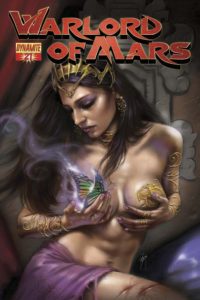 A number of comics are now exploring the Barsoom universe and other John Carter stories. Is a serial format like this, or even television, the best place for Burroughs?
A number of comics are now exploring the Barsoom universe and other John Carter stories. Is a serial format like this, or even television, the best place for Burroughs?
Jim Sullos: People were amazed at the amount of content that was included in John Carter and since this is just one of the eleven Mars books he wrote, I think it’s clear that the storyline could continue for a long time and not run out material. It would seem that this would lend itself well to a serial format which prevents it from every getting stale.
Which stories by Edgar Rice Burroughs have been done before in films, TV series or cartoons?
Cathy Wilbanks: There have been several properties developed into films, tv series and/or cartoons. First, (of course) John Carter is a major motion picture just released by Disney in 2012. Second, Tarzan has been hugely successful. There were over 50 movies and 6 television series made (including 2 animation). Third, “Land that Time Forgot” was a movie and television series in 1975. It resulted in two sequels “People that Time Forgot” and “At the Earth’s Core.” Finally, “Jungle Girl” was developed into a series and later was pieced together to make a film. Many people don’t realize that Edgar Rice Burroughs wrote in many different genres and when he put his pen down for the last time, he left us with over 70 novels and 40 short stories. There is tremendous potential for future movie/t.v. success.
How much say did Edgar Rice Burroughs Inc have in how the film was brought to the screen?
Jim Sullos: We were involved early on in the script development ensuring that the storyline was consistent with the basic elements of the book.
How well do you think the film captured Burroughs’ descriptions of Mars and his creature creations?
Jim Sullos: Very well now that there has been a full utilization of CGI. Andrew Stanton’s intimate knowledge of all elements of the storyline became clear in the visualization he provided of the Mars landscape, detailed description of individuals and precise battle scenes.
 What’s the one Burroughs adaptation you would love to see?
What’s the one Burroughs adaptation you would love to see?
Cathy Wilbanks: I would love to see the development of “The Monster Men.” It is a story about a scientist who builds an army of soldiers who don’t have a conscience and/or feelings. Soldier number 13 turns out differently and ruins the plan. Of course, there is a love story, a lot of action, and a wonderful ending…
How did you feel Taylor Kitsch portrayed such an iconic role such as John Carter?
Jim Sullos: Having seen only one of his prior films I was not totally familiar with his acting style, but I was pleased with his portrayal of John Carter as a damaged and exhausted Civil War veteran and the slow but noticeable progression of the character as he assumed his heroic status.
What kind of care is required to safekeep some of the older items in the Burroughs archive?
Cathy Wilbanks: Storage and handling is vital to the preservation of older artifacts. I’ve learned to always wear white gloves when handling any paper items and to always store items away from the sun. We have tried to scan in everything possible so we don’t have to handle the originals. I love to organize things and it is really rewarding to preserve history.
The John Carter books are free to read for most e-book users. Has this, and the film, caused a rise in popularity for John Carter?
Jim Sullos: These stories have been around now for 100 years and that in itself is a remarkable achievement. The fact that there has been renewed interest is demonstrated by current book sales and by the making of an incredible film, John Carter.
The covers for many of the John Carter books feature fantastic artwork. Does ERB Inc own these pieces or have the rights to them? I would love to see them collected in a coffeetable book or put on display.
Cathy Wilbanks: Me too! The art of John Carter is definitely fantastic and would make a great coffee table book. It has always been company policy to own the copyright of all images, so yes, we do own the art.
If you had to pick a favorite moment in John Carter, what would it be?
Jim Sullos: I was always interested in seeing how the Tharks would appear on screen so I was fascinated by the first appearance of the Tharks epitomized by Tars Tarkas.
Are there plans to have one, or a traveling exhibit of his artifacts?
Cathy Wilbanks: There is currently a display of TARZAN memorabilia in an Air Museum in Patterson, Louisiana and another display in Oak Park, Illinois available for fans. Of course, we often refer to our office in Tarzana, CA as 1/3 office, 1/3 library and 1/3 museum. We have many artifacts on display and always welcome fans with advanced notice!
Did you and your coworkers feel pressure to live up to EGB’s legacy?
Jim Sullos: Not that we feel pressure but all of us at the corporation feel a great commitment to keep the legacy of Edgar Rice Burroughs alive. There is such a rich universe of material that reflects his creative genius. Our job is to bring it to life.
Since John Carter was so wonderfully realized onscreen, are there any efforts underway to give…”The Land That Time Forgot” a shot next?
Jim Sullos: [W]e have had discussions with a producer who would like to redo “The Land That Time Forgot” in 3D but it has not been consummated yet.
Can you give us more details about the featurette “100 Years In The Making”? What was your role in putting it together? Was it fun? How does it feel to have it on the Blu-ray disc of the film?
Cathy Wilbanks: I really enjoyed participating in the featurette “100 Years In the Making.” The Disney crew came in to interview Jim and I and we were really impressed with their thoughts and direction. We shared several historical photos of Edgar Rice Burroughs as a man and an author and also recommended John Burroughs, the grandson of Edgar Rice Burroughs, to play the part of his granddad. My role was to supply the images and to provide any feedback as it was developed. I am thrilled to have it on the Blu-ray because I am hoping it will increase awareness of who Edgar Rice Burroughs was and his contribution to the Sci-fi world.
How do you make the stories of ERB relevant and in the forefront with today’s evolving culture?
Jim Sullos: Edgar Rice Burroughs stories stay relevant because they appeal to the basic human traits that prevail in the long term so they never go out of style. He created heroes that were strong, noble and had a great instinct of what was “right”. In the current era the anti-hero (to be bad is good) is very popular but it is ironic that in the end all the anti-heroes end up with all the enduring virtues that old-fashioned heroes had.
Cathy Wilbanks: It is amazing to me to think that Edgar Rice Burroughs began writing back in 1911. It really illustrates the fact that he was a visionary and far advanced for his time. Edgar Rice Burroughs wrote for entertainment and included human elements to appeal to all generations. He was a gifted writer that could transport the reader to another world. His stories are still relevant to today’s audience because they are filled with action, love, humor, and a strong hero that develops over the storyline.
Are there any surviving materials from Robert Clampett’s attempt to make “A Princess of Mars”?
Jim Sullos: Yes. Edgar Rice Burroughs’ son, John Coleman Burroughs, had modeled a wooden Thoat (eight-legged horse), a life-sized sword made of wood and a paper mache mask of what a Thark should look like. These are all contained in our archives.
I’m not familiar with the “Venus” series. How does it differ from the Mars series of books? Do they share any characters or are they totally separate casts of characters?
Jim Sullos: The only similarity between the Mars and the Venus stories is that in the Venus stories, the hero Carson Napier had planned to land his spaceship on Mars but incorrectly calibrated and ended up on Venus where he discovered an entirely unknown world forever hidden from earth by a dense cloud bank. Beyond that Carson Napier has his own adventures over five books that are exclusively devoted to Venus with a different cast of characters leading to him becoming the Emperor of Venus married to a beautiful Princess named Duare.
What is one fact most people do not know about ERB that they might find especially interesting?
Cathy Wilbanks: Edgar Rice Burroughs was not “officially” educated to be a writer. He didn’t start writing until he was 35 years old and only after trying many other professions. Once he made the leap, he was a brilliant enterpreneur who embraced his profession in every way possible and was highly successful because of it. He kept journals, made maps, developed languages and sketched out the characters of his story lines. Overall, he wrote over 70 novels and 40 short stories which have been translated into 35 languages.
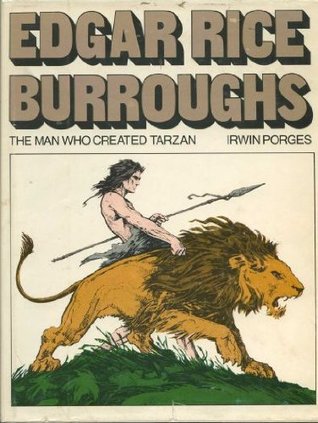 Is there a definitive written biography and / or a film documentary on Edgar Rice Burroughs that you think is best?
Is there a definitive written biography and / or a film documentary on Edgar Rice Burroughs that you think is best?
Cathy Wilbanks: The best written biography is written by Irwin Porges called “Edgar Rice Burroughs: The Man who Created Tarzan.” There are several documentaries in existence including one by A&E but we are currently in development on one.
How were ERB’s books received during his time? Was he successful or were they too far ahead of their time, and appreciated later?
Jim Sullos: He was definitely one of the best selling authors throughout his career. The immense popularity of both A Princess of Mars and Tarzan of the Apes created a huge demand for sequels which lead to him writing 24 Tarzan novels and 11 Mars novels, all but one of which were published during his lifetime. It is estimated that approximately 100 million of his books were sold, most of which were sold before he passed away. It is also estimated that including books, movies, comic strips and comic books that his stories reached 1 billion people.
Jim, any final thoughts on John Carter?
Jim Sullos: I’m extremely appreciative that Disney was willing to bring visualization to this beloved story through what I’m sure will become a classic movie. It will endure over time because the film has reinvigorated a huge fan base that is anxiously looking for more.
Cathy, any final thoughts on John Carter?
Cathy Wilbanks: It has been a real pleasure to participate in this round table. Thank you for all of your questions and for supporting the project. The movie John Carter is really a dream come true for the corporation as well as the fans and family. When I starting working for Edgar Rice Burroughs, Inc. back in 1984, I was fortunate enough to work with Danton Burroughs, the grandson of ERB. His passion and vision was inspiring and I am honored to be apart of this project. At that time, it seemed the hurdles were too large to result in a movie so now, we are thrilled to actually see it on the big screen.

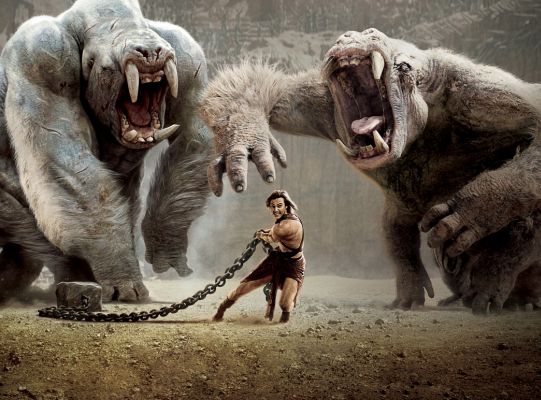

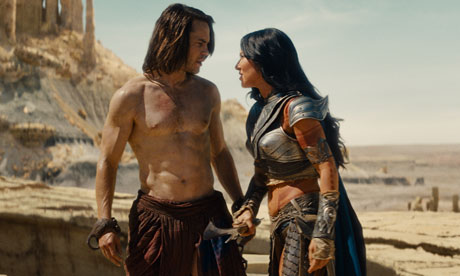



I loved the film, saw it three times which is very rare for me. It reminded me of when I was a youth, watching films with my dad, they don’t make films like this anymore. I certainly hope they make a sequel!
”
On the contrary, the movie included a fairly faithful depiction of the storyline from the first book “A Princess of Mars” and actually brought in an additional storyline from the second novel “The Gods of Mars” when the Therns became an integral part of the movie. That leaves open the question of what the Therns plans are to invade planet earth and have the same sinister impact that it has had on Mars.”
Except, of course, that in the books the Therns had no plans to invade Earth, so how could this be a “faithful depiction of the storyline”? And who added all that rubbish about the Therns to the movie?